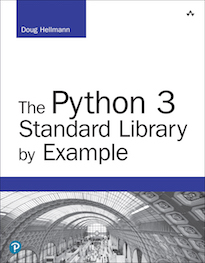smtplib – Simple Mail Transfer Protocol client¶
| Purpose: | Interact with SMTP servers, including sending email. |
|---|---|
| Available In: | 1.5.2 and later |
smtplib includes the class SMTP, which is useful for communicating with mail servers to send mail.
Note
The email addresses, host names, and IP addresses in the following examples have been obscured, but otherwise the transcripts illustrate the sequence of commands and responses accurately.
Sending an Email Message¶
The most common use of SMTP is to connect to a mail server and send a message. The mail server host name and port can be passed to the constructor, or you can use connect() explicitly. Once connected, just call sendmail() with the envelope parameters and body of the message. The message text should be a fully formed RFC 2882-compliant message, since smtplib does not modify the contents or headers at all. That means you need to add the From and To headers yourself.
import smtplib
import email.utils
from email.mime.text import MIMEText
# Create the message
msg = MIMEText('This is the body of the message.')
msg['To'] = email.utils.formataddr(('Recipient', 'recipient@example.com'))
msg['From'] = email.utils.formataddr(('Author', 'author@example.com'))
msg['Subject'] = 'Simple test message'
server = smtplib.SMTP('mail')
server.set_debuglevel(True) # show communication with the server
try:
server.sendmail('author@example.com', ['recipient@example.com'], msg.as_string())
finally:
server.quit()
In this example, debugging is also turned on to show the communication between client and server. Otherwise the example would produce no output at all.
$ python smtplib_sendmail.py
send: 'ehlo localhost.local\r\n'
reply: '250-mail.example.com Hello [192.168.1.17], pleased to meet you\r\n'
reply: '250-ENHANCEDSTATUSCODES\r\n'
reply: '250-PIPELINING\r\n'
reply: '250-8BITMIME\r\n'
reply: '250-SIZE\r\n'
reply: '250-DSN\r\n'
reply: '250-ETRN\r\n'
reply: '250-AUTH GSSAPI DIGEST-MD5 CRAM-MD5\r\n'
reply: '250-DELIVERBY\r\n'
reply: '250 HELP\r\n'
reply: retcode (250); Msg: mail.example.com Hello [192.168.1.17], pleased to meet you
ENHANCEDSTATUSCODES
PIPELINING
8BITMIME
SIZE
DSN
ETRN
AUTH GSSAPI DIGEST-MD5 CRAM-MD5
DELIVERBY
HELP
send: 'mail FROM:<author@example.com> size=266\r\n'
reply: '250 2.1.0 <author@example.com>... Sender ok\r\n'
reply: retcode (250); Msg: 2.1.0 <author@example.com>... Sender ok
send: 'rcpt TO:<recipient@example.com>\r\n'
reply: '250 2.1.5 <recipient@example.com>... Recipient ok\r\n'
reply: retcode (250); Msg: 2.1.5 <recipient@example.com>... Recipient ok
send: 'data\r\n'
reply: '354 Enter mail, end with "." on a line by itself\r\n'
reply: retcode (354); Msg: Enter mail, end with "." on a line by itself
data: (354, 'Enter mail, end with "." on a line by itself')
send: 'From nobody Sun Sep 28 10:02:48 2008\r\nContent-Type: text/plain; charset="us-ascii"\r\nMIME-Version: 1.0\r\nContent-Transfer-Encoding: 7bit\r\nTo: Recipient <recipient@example.com>\r\nFrom: Author <author@example.com>\r\nSubject: Simple test message\r\n\r\nThis is the body of the message.\r\n.\r\n'
reply: '250 2.0.0 m8SE2mpc015614 Message accepted for delivery\r\n'
reply: retcode (250); Msg: 2.0.0 m8SE2mpc015614 Message accepted for delivery
data: (250, '2.0.0 m8SE2mpc015614 Message accepted for delivery')
send: 'quit\r\n'
reply: '221 2.0.0 mail.example.com closing connection\r\n'
reply: retcode (221); Msg: 2.0.0 mail.example.com closing connection
Notice that the second argument to sendmail(), the recipients, is passed as a list. You can include any number of addresses in the list to have the message delivered to each of them in turn. Since the envelope information is separate from the message headers, you can even BCC someone by including them in the method argument but not in the message header.
Authentication and Encryption¶
The SMTP class also handles authentication and TLS (transport layer security) encryption, when the server supports them. To determine if the server supports TLS, call ehlo() directly to identify your computer to the server and ask it what extensions are available. Then call has_extn() to check the results. Once TLS is started, you must call ehlo() again before authenticating.
import smtplib
import email.utils
from email.mime.text import MIMEText
import getpass
# Prompt the user for connection info
to_email = raw_input('Recipient: ')
servername = raw_input('Mail server name: ')
username = raw_input('Mail user name: ')
password = getpass.getpass("%s's password: " % username)
# Create the message
msg = MIMEText('Test message from PyMOTW.')
msg.set_unixfrom('author')
msg['To'] = email.utils.formataddr(('Recipient', to_email))
msg['From'] = email.utils.formataddr(('Author', 'author@example.com'))
msg['Subject'] = 'Test from PyMOTW'
server = smtplib.SMTP(servername)
try:
server.set_debuglevel(True)
# identify ourselves, prompting server for supported features
server.ehlo()
# If we can encrypt this session, do it
if server.has_extn('STARTTLS'):
server.starttls()
server.ehlo() # re-identify ourselves over TLS connection
server.login(username, password)
server.sendmail('author@example.com', [to_email], msg.as_string())
finally:
server.quit()
Notice that STARTTLS does not appear in the list of extensions (in the reply to EHLO) once TLS is enabled.
$ python smtplib_authenticated.py
Recipient: recipient@example.com
Mail server name: smtpauth.isp.net
Mail user name: user@isp.net
user@isp.net's password:
send: 'ehlo localhost.local\r\n'
reply: '250-elasmtp-isp.net Hello localhost.local [<your IP here>]\r\n'
reply: '250-SIZE 14680064\r\n'
reply: '250-PIPELINING\r\n'
reply: '250-AUTH PLAIN LOGIN CRAM-MD5\r\n'
reply: '250-STARTTLS\r\n'
reply: '250 HELP\r\n'
reply: retcode (250); Msg: elasmtp-isp.net Hello localhost.local [<your IP here>]
SIZE 14680064
PIPELINING
AUTH PLAIN LOGIN CRAM-MD5
STARTTLS
HELP
send: 'STARTTLS\r\n'
reply: '220 TLS go ahead\r\n'
reply: retcode (220); Msg: TLS go ahead
send: 'ehlo localhost.local\r\n'
reply: '250-elasmtp-isp.net Hello localhost.local [<your IP here>]\r\n'
reply: '250-SIZE 14680064\r\n'
reply: '250-PIPELINING\r\n'
reply: '250-AUTH PLAIN LOGIN CRAM-MD5\r\n'
reply: '250 HELP\r\n'
reply: retcode (250); Msg: elasmtp-isp.net Hello farnsworth.local [<your IP here>]
SIZE 14680064
PIPELINING
AUTH PLAIN LOGIN CRAM-MD5
HELP
send: 'AUTH CRAM-MD5\r\n'
reply: '334 PDExNjkyLjEyMjI2MTI1NzlAZWxhc210cC1tZWFseS5hdGwuc2EuZWFydGhsaW5rLm5ldD4=\r\n'
reply: retcode (334); Msg: PDExNjkyLjEyMjI2MTI1NzlAZWxhc210cC1tZWFseS5hdGwuc2EuZWFydGhsaW5rLm5ldD4=
send: 'ZGhlbGxtYW5uQGVhcnRobGluay5uZXQgN2Q1YjAyYTRmMGQ1YzZjM2NjOTNjZDc1MDQxN2ViYjg=\r\n'
reply: '235 Authentication succeeded\r\n'
reply: retcode (235); Msg: Authentication succeeded
send: 'mail FROM:<author@example.com> size=221\r\n'
reply: '250 OK\r\n'
reply: retcode (250); Msg: OK
send: 'rcpt TO:<recipient@example.com>\r\n'
reply: '250 Accepted\r\n'
reply: retcode (250); Msg: Accepted
send: 'data\r\n'
reply: '354 Enter message, ending with "." on a line by itself\r\n'
reply: retcode (354); Msg: Enter message, ending with "." on a line by itself
data: (354, 'Enter message, ending with "." on a line by itself')
send: 'Content-Type: text/plain; charset="us-ascii"\r\nMIME-Version: 1.0\r\nContent-Transfer-Encoding: 7bit\r\nTo: Recipient <recipient@example.com>\r\nFrom: Author <author@example.com>\r\nSubject: Test from PyMOTW\r\n\r\nTest message from PyMOTW.\r\n.\r\n'
reply: '250 OK id=1KjxNj-00032a-Ux\r\n'
reply: retcode (250); Msg: OK id=1KjxNj-00032a-Ux
data: (250, 'OK id=1KjxNj-00032a-Ux')
send: 'quit\r\n'
reply: '221 elasmtp-isp.net closing connection\r\n'
reply: retcode (221); Msg: elasmtp-isp.net closing connection
Verifying an Email Address¶
The SMTP protocol includes a command to ask a server whether an address is valid. Usually VRFY is disabled to prevent spammers from finding legitimate email addresses, but if it is enabled you can ask the server about an address and receive a status code indicating validity along with the user’s full name, if it is available.
import smtplib
server = smtplib.SMTP('mail')
server.set_debuglevel(True) # show communication with the server
try:
dhellmann_result = server.verify('dhellmann')
notthere_result = server.verify('notthere')
finally:
server.quit()
print 'dhellmann:', dhellmann_result
print 'notthere :', notthere_result
As the last 2 lines of output here show, the address dhellmann is valid but notthere is not.
$ python smtplib_verify.py
send: 'vrfy <dhellmann>\r\n'
reply: '250 2.1.5 Doug Hellmann <dhellmann@mail.example.com>\r\n'
reply: retcode (250); Msg: 2.1.5 Doug Hellmann <dhellmann@mail.example.com>
send: 'vrfy <notthere>\r\n'
reply: '550 5.1.1 <notthere>... User unknown\r\n'
reply: retcode (550); Msg: 5.1.1 <notthere>... User unknown
send: 'quit\r\n'
reply: '221 2.0.0 mail.example.com closing connection\r\n'
reply: retcode (221); Msg: 2.0.0 mail.example.com closing connection
dhellmann: (250, '2.1.5 Doug Hellmann <dhellmann@mail.example.com>')
notthere : (550, '5.1.1 <notthere>... User unknown')
See also
- smtplib
- Standard library documentation for this module.
- RFC 821
- The Simple Mail Transfer Protocol (SMTP) specification.
- RFC 1869
- SMTP Service Extensions to the base protocol.
- RFC 822
- “Standard for the Format of ARPA Internet Text Messages”, the original email message format specification.
- RFC 2822
- “Internet Message Format”, updates to the email message format.
- Standard library module for parsing email messages.
- smtpd
- Implements a simple SMTP server.

